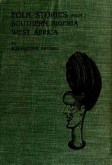Why the Worms live Underneath the Ground
Nigerian Folktale
When Eyo III. was ruling over all men and animals, he had a very big palaver house to which he used to invite his subjects at intervals to feast. After the feast had been held and plenty of tombo had been drunk, it was the custom of the people to make speeches. One day after the feast the head driver ant got up and said he and his people were stronger than any one, and that no one, not even the elephant, could stand before him, which was quite true. He was particularly offensive in his allusions to the worms (whom he disliked very much), and said they were poor wriggling things.
The worms were very angry and complained, so the king said that the best way to decide the question who was the stronger was for both sides to meet on the road and fight the matter out between themselves to a finish. He appointed the third day from the feast for the contest, and all the people turned out to witness the battle.
The driver ants left their nest in the early morning in thousands and millions, and, as is their custom, marched in a line about one inch broad densely packed, so that it was like a dark-brown band moving over the country. In front of the advancing column they had out their scouts, advance guard, and flankers, and the main body followed in their millions close behind.
When they came to the battlefield the moving band spread out, and as the thousands upon thousands of ants rolled up, the whole piece of ground was a moving mass of ants and bunches of struggling worms. The fight was over in a very few minutes, as the worms were bitten in pieces by the sharp pincer-like mouths of the driver ants. The few worms who survived squirmed away and buried themselves out of sight.
King Eyo decided that the driver ants were easy winners, and ever since the worms have always been afraid and have lived underground; and if they happen to come to the surface after the rain they hide themselves under the ground whenever anything approaches, as they fear all people.
Folk Stories from Southern Nigeria

Notes: Contains 40 Nigerian folktales. The introduction is written by Andrew Lang.
Author: Elphinstone Dayrell
Published: 1910
Publisher:Longmans, Green and Co., London, New York, Bombay & Calcutta